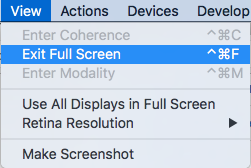By default, Parallels Desktop maps common Mac OS X keyboard shortcut key combinations to the equivalent Windows key combinations. Full Screen, and Window view modes, and for showing and hiding Parallels Desktop in the Application Shortcuts menu, which I’ll cover in a moment. Parallels Desktop Application Shortcuts allows you to access Parallels VM settings and change view modes. To find the list of key combinations for Parallels Desktop, go to the Parallels Desktop menu bar at the top Mac menu bar, choose Parallels Desktop → Preferences → Shortcuts, and select Application Shortcuts.
Parallels today announced Parallels Desktop 12 for Mac with support for macOS Sierra and the addition of several new features. The company also announced a new standalone app called Parallels Toolbox, which allows users to perform some simple tasks that aren't necessarily tied to virtualization.New features in Desktop 12 include having Windows 10 'always on' in the background, the ability to instantly launch Windows apps, the ability to schedule incremental backups and Windows updates, the ability to assign special behaviors to Windows apps, improved integration for Microsoft Edge, Outlook, and Office 365, and Xbox app support. Additionally, Parallels has partnered with Blizzard to provide specific support for the hit game Overwatch.
Version 12 also includes 90 percent faster snapshot creation, 60 percent faster suspension of VMs, 25 percent faster shared folder performance, 25 percent faster compilation of Visual Studio projects, and up to 10 percent in battery life improvements for 'certain environments.'
Amc 12 La Jolla
The company is also touting a new standalone app called Parallels Toolbox. The Toolbox places a drop-down menu in the Mac's menu bar, allowing users to do certain tasks more quickly. Tasks include the ability to record the screen, take screenshots, record audio, archive files, convert and download video, lock the screen and more.Parallels Desktop 12 for Mac is $79.99, while Desktop 10 or 11 users may upgrade for $49.99. The Business and Pro Editions are also available with a subscription fee of $99.99 per year, although Parallels 10 and 11 users with perpetual licenses can upgrade for $49.99 per year. Parallels Toolbox can be purchased for $10 per year or will be included with your Parallels Desktop 12 license.
Parallels 10 and 11 users can upgrade now at the company's website. New users can purchase Parallels 12 starting on August 23. Parallels Toolbox also launches August 23.
Parallels is best known to Mac users as one of the handful of companies—including VMWare and a couple of others—that make apps enabling you to run Windows on your Mac. Now the company is entering a much more crowded niche: Its new iOS app Parallels Access lets you connect to a remote Mac from your iPad and so 'run' Mac apps on your tablet. In doing so, it joins the likes of GoToMyPC, LogMeIn, TeamViewer HD, and SplashTop Remote Desktop, as well as VNC clients like Mocha VNC, among many, many others.
So if Parallels Access isn’t exactly unique in what it does, how does it expect to differentiate itself in that crowded field? By making remotely accessed Mac programs act as much like native iOS apps as possible. Based on my preliminary testing with the app, here’s how it works.
Installation and setup

Installing Parallels Access is a simple, two-step process. First you install an iOS client via the App Store. From that client app, you log into your existing Parallels account or create a new one. You then install a Mac “agent” on your desktop or laptop and log into that same account from there; the Mac app must be running in order for the remote access to work. (The Mac installer is smart enough to check your system’s sleep settings and advise you whether you need to adjust them; if your Mac goes to sleep while you’re remotely accessing it from your iPad, you’ll be out of business.) There’s an Access agent for Windows machines, too, so you can control those from your iPad as well.
With those two bits of software in place, you launch the iPad app, which will then show you a list of the Macs that are registered to your account.
Tap on the one you want and you’ll enter a Launchpad-like interface showing you a bunch of your Mac apps. (Which is to say it looks like a standard iOS home screen, but with Mac icons.)
Parallels says that, by default, this initial list shows the Mac apps you use most commonly, but you can add and delete apps as you see fit: Just tap the Edit button in the upper right corner to delete or the plus-sign (+) to add. There’s also a handy search field, which will find any app with your search string, not just those on that default home screen.
The interface
When you tap on one of the icons on that home screen, the Mac app opens smoothly; I noticed no lag between my taps and the app’s response. (That’s not always the case with this kind of remote access.) If you were near the Mac you’re connecting to, you’d see the app open in full-screen mode on your Mac’s display(s). You could type and move the cursor from your Mac input devices, but the interface would be zoomed in on the one app that’s open on your tablet.
Access isn’t just mirroring your Mac’s screen on your iPad: It’s overlaying its own interface on your OS X apps. That means you interact with Mac apps by tapping, tapping-and-holding, clicking, dragging, and so on. A regular one-finger tap on the iPad produces a single left-click on your Mac, a two-finger tap creates a right-click, a slide of your finger scrolls the screen, and so on.
On the right side of the screen, you’ll see a small toolbar with four icons on it. You can swipe over the toolbar left-to-right to hide it, then swipe in from right edge of the screen to have it reappear.
The top icon on that toolbar summons a Dock-like interface at the bottom of the screen, showing all of the apps that are currently open on your Mac. To switch to another app, you tap its icon there.
Below that on the toolbar there’s a Launchpad icon; you use that to summon that initial home screen with your Mac app icons; you can open new apps there.
Next there’s the familiar gear icon for settings. Tap on that to control six settings:

- Additional Keys (which lets you summon special keyboard keys, about which more below);
- Mouse Pointer (tap on that to get a mouse-click toolbar that makes it easier to effect left- or right-clicks);
- Desktop Mode (which gives you a fuller OS X desktop, including the top menubar and the Dock);
- Sound On/Off;
- Feedback; and
- Help.
Finally, below that Settings icon, there’s a keyboard button that summons the Access keyboard. That keyboard is the standard iOS one, plus a set of special keys at the top: Escape; Tab; F1 through F12 keys; Delete; a button with a grid-like icon on it that, when tapped provides Home, End, PgUp, and PgDn keys; Shift; Ctrl; Alt; Command; and cursor arrow keys.
The Access keyboard doesn’t let you “chord” keys—in other words, you can’t use standard OS X keyboard combinations such as ⌘-B, ⌘-C, and so on. Instead, you must use the iOS-standard context menu (summoned by selecting text or whatever else you’re working on, depending on the app, then tapping the selection). On the plus side, you can use iPad dictation for input in your Mac apps.
Because you’re running OS X, you can run multiple apps at once, switching from one to the other using that app-switcher button in the toolbar. But because you’re in iOS, the Access interface is really optimized for running one app at a time. So if you need to hop among multiple apps, the Access interface could be frustrating.
Tapping on elements of an app’s interface—buttons in the Office ribbon, for example—works really well, in part because Parallels intelligently interprets taps that are close to buttons; you don’t have to hit them exactly.
Final thought
Mac 12 380
While Parallels Access does indeed provide a nice, smooth iOS interface to Mac programs, that’s not to say the app does so uniquely enough to clearly distinguish itself from the other iPad apps that do much the same thing. For that final word (as well as word on whether and how well you can stream video or transfer files from your Mac to iPad), you’ll have to wait for our review.
Mac 12 Gun
Parallels Access will sell for an $80 annual subscription; you’ll need a separate subscription for each Mac (and PC) agent you install.